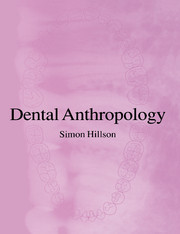Book contents
- Frontmatter
- Contents
- Acknowledgements
- Abbreviations
- 1 Introduction to dental anthropology
- 2 Dental anatomy
- 3 Variation in size and shape of teeth
- 4 Occlusion
- 5 Sequence and timing of dental growth
- 6 Dental enamel
- 7 Dentine
- 8 Dental cement
- 9 Histological methods of age determination
- 10 Biochemistry of dental tissues
- 11 Tooth wear and modification
- 12 Dental disease
- 13 Conclusion: current state, challenges and future developments in dental anthropology
- Appendix A: Field and laboratory methods
- Appendix B: Microscopy
- References
- Index
Appendix B: Microscopy
Published online by Cambridge University Press: 05 June 2012
- Frontmatter
- Contents
- Acknowledgements
- Abbreviations
- 1 Introduction to dental anthropology
- 2 Dental anatomy
- 3 Variation in size and shape of teeth
- 4 Occlusion
- 5 Sequence and timing of dental growth
- 6 Dental enamel
- 7 Dentine
- 8 Dental cement
- 9 Histological methods of age determination
- 10 Biochemistry of dental tissues
- 11 Tooth wear and modification
- 12 Dental disease
- 13 Conclusion: current state, challenges and future developments in dental anthropology
- Appendix A: Field and laboratory methods
- Appendix B: Microscopy
- References
- Index
Summary
Light microscopy
Further reading
Hartley (1979), Bradbury (1984) and Schmidt & Keil (1971).
The limits of simple observation
Some details of dental histology can be made out with minimal magnification. Unaided, the human eye easily resolves dots 200 μm apart, in a specimen held 250 mm away. At best, the eye resolves 70 μm, and a hand lens or loupe may resolve 10μm – the main limitation is in lighting the object well enough.
Compound microscopes
Serious dental histology, however, relies on compound microscopes, with an objective lens that forms the primary image and provides the resolving power, and an eyepiece lens that provides secondary magnification. A microscope for dental studies might have × 1 or × 4, × 10 and × 40 objectives, with × 10 and × 15 eyepieces, altogether giving a range of magnifications from × 10 to × 600. A moderately good × 10 objective might have a resolving power of 1 μm and a field depth (the thickness of the plane of focus) of 10 μm, and a similar quality × 40 objective might have a 0.4 μm resolving power and 2 μm depth of field.
Most microscopes can be fitted with a purpose-built camera, but it is also possible to obtain fittings for most ordinary 35 mm cameras. An alternative approach is to use a television camera connected to a computer-based image analysis system. Images are stored, filtered and enhanced, and measured.
- Type
- Chapter
- Information
- Dental Anthropology , pp. 309 - 315Publisher: Cambridge University PressPrint publication year: 1996



